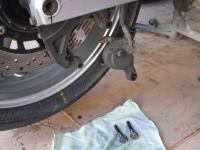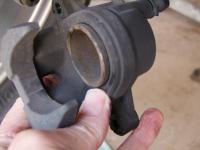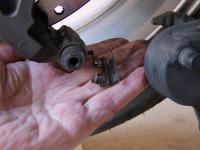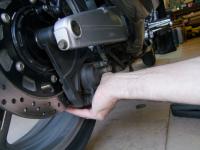mcatrophy
Privileged to ride a 2018 FJR1300AS
To cut a long storey short, I wanted to see if anything was causing my rear wheel to bind. Naturally when you try to spin it, the brake pads rub gently on the disc, quite enough so that the wheel doesn't spin freely.
I wanted to free the brake off completely, the obvious way was to take the calliper off. But, having just had it all off, cleaned it all up and put it all back, ...
(Click on image for larger view)



...I really didn't want to take it all off again.
Then the little bulb lit up
 .
.
I used the heel of my hand against the calliper with a firm, steady pressure,

which dutifully pushed its piston in, so freeing the pads completely from the disc
 .
.
Now the wheel would spin happily, with only the resistance of bearings and drive shaft
 .
.
Might be useful to someone out there.
Most importantly, don't forget to operate the lever a few times before riding ...
I wanted to free the brake off completely, the obvious way was to take the calliper off. But, having just had it all off, cleaned it all up and put it all back, ...
(Click on image for larger view)



...I really didn't want to take it all off again.
Then the little bulb lit up
I used the heel of my hand against the calliper with a firm, steady pressure,

which dutifully pushed its piston in, so freeing the pads completely from the disc
Now the wheel would spin happily, with only the resistance of bearings and drive shaft
Might be useful to someone out there.
Most importantly, don't forget to operate the lever a few times before riding ...



